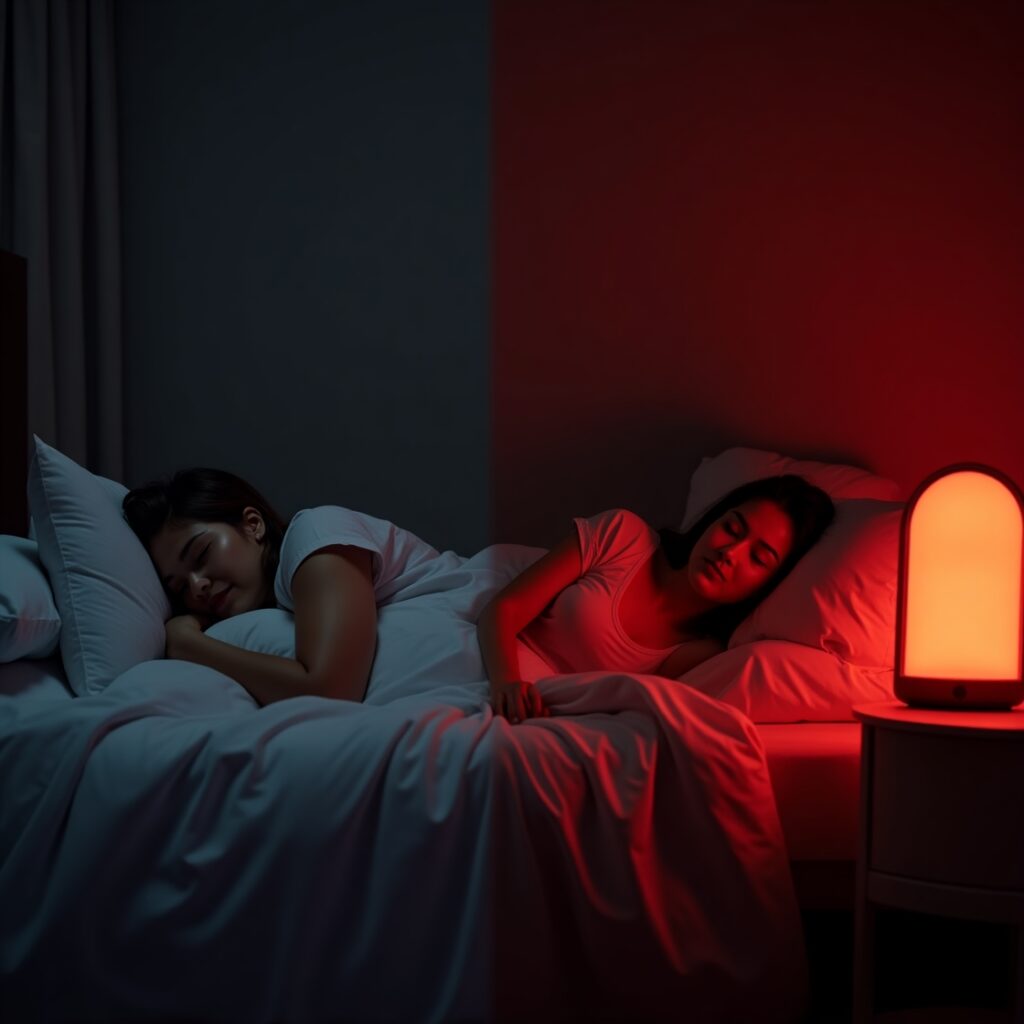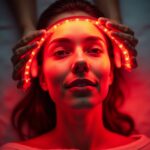Introduction: Why Red Light Therapy for Sleep Matters

We’ve all been there—staring at the ceiling at 2 a.m., desperate for rest, frustrated by our wired minds. If that’s you, you’re far from alone. According to the CDC, 1 in 3 adults in the U.S. don’t get enough sleep. The consequences? Fatigue, brain fog, poor performance, and long-term health issues.
But what if there were a natural, non-pharmaceutical way to support better sleep? That’s where red light therapy for sleep enters the picture. This innovative wellness treatment, once exclusive to elite clinics and biohackers, is now accessible to everyone.
In this comprehensive guide, you’ll discover:
- The science behind red light therapy for sleep
- How to use red light therapy before bed
- Which red light wavelengths work best (660nm & 850nm)
- The best red light therapy devices for sleep
- Tips for integrating red light therapy into your nighttime routine
Whether you struggle with insomnia, jet lag, or just poor sleep quality, red light therapy for sleep may be your new secret weapon. Let’s explore how this gentle, therapeutic light can help you rest better—naturally.
What is Red Light Therapy?

Red light therapy (RLT), also known as photobiomodulation, involves exposing the body to specific wavelengths of red and near-infrared light. This therapy typically uses LED devices that emit wavelengths between 660nm (red light) and 850nm (near-infrared light).
Here’s what makes it unique:
- Photobiomodulation: RLT works at the cellular level to stimulate the mitochondria, the powerhouse of your cells, helping them produce more ATP (energy).
- Therapeutic Wavelengths: 660nm and 850nm are proven to penetrate tissues effectively, supporting everything from muscle recovery to sleep enhancement.
- FDA-Approved Devices: Many RLT devices are registered with the FDA for safety and effectiveness, especially for managing pain and skin conditions.
Unlike blue light, which disrupts sleep by suppressing melatonin, red and near-infrared light support circadian rhythm regulation and may enhance melatonin production naturally.
The Science Behind Red Light Therapy for Sleep
To understand red light therapy for sleep, we must first look at how light affects our circadian rhythm and melatonin levels.
Circadian Rhythm Regulation
Your circadian rhythm is your internal body clock that governs your sleep-wake cycle. Red light therapy helps reset this rhythm by signaling to the brain that it’s time to wind down.
Melatonin Production Enhancement
Exposure to red light in the evening has been shown to increase melatonin production, the hormone responsible for inducing sleep. Unlike blue light from screens, red light does not suppress melatonin.
Mitochondrial Function and ATP
Red light stimulates mitochondrial activity, increasing ATP production. This cellular energy boost can help regulate hormonal balance and improve sleep quality.
Clinical Studies & Research
Several studies suggest the sleep improvement results of red light therapy:
- A 2012 study in the Journal of Athletic Training found that female athletes who used red light therapy experienced better sleep quality and increased melatonin levels.
- A 2020 review published in Nature and Science of Sleep noted that photobiomodulation could be a promising treatment for insomnia.
“Red light therapy appears to promote natural melatonin production, helping the body enter a state of rest without pharmaceutical intervention.” — Dr. Sarah Wong, Sleep Specialist
Expert Insights
Dr. Michael Hamblin, a leading researcher in photobiomodulation, states that “red and near-infrared light can penetrate deeper tissues, positively affecting neurological processes that regulate sleep cycles.”
How Red Light Therapy Improves Sleep Quality
Mechanisms of Action
- Promotes natural melatonin support
- Resets circadian rhythm through hypothalamic signaling
- Enhances cellular recovery during sleep
Sleep Cycle Optimization
By supporting melatonin levels, red light helps align your internal clock with natural night cues. This aids in a smoother transition into deep sleep.
Reduction of Sleep Latency
Users report falling asleep faster, likely due to reduced cortisol levels and relaxed muscle tone.
Deeper Sleep Phases
Improved REM and deep sleep phases have been noted in anecdotal accounts and small-scale studies.
Improved Morning Alertness
A balanced sleep cycle results in feeling more refreshed upon waking—no groggy hangover from sleep aids.
Benefits of Red Light Therapy for Sleep Disorders
Red light therapy for sleep offers benefits for a variety of sleep-related issues:
Insomnia Treatment
Those with insomnia may benefit from regular exposure to red light therapy before bed, promoting a calming, sleep-inducing environment, according to research summarized by the Mayo Clinic.
Shift Work Sleep Disorder
RLT can help realign circadian rhythms disrupted by irregular schedules.
Seasonal Affective Disorder (SAD)
Red light exposure may help those affected by SAD by stimulating melatonin production and mood regulation.
Jet Lag Recovery
Using RLT before and after flights may help your body adjust faster to new time zones.
Age-Related Sleep Changes
Older adults often experience reduced melatonin. Red light therapy offers a non-pharmaceutical sleep solution to support hormone balance.
How to Use Red Light Therapy for Sleep
Optimal Timing
Use your device 1–2 hours before bedtime to maximize melatonin production without overstimulating the system.
Duration Recommendations
- Start with 10–15 minutes per session
- Increase gradually up to 20 minutes
Distance from Device
Keep the device 6–18 inches away depending on intensity.
Body Positioning
Target areas like the face, neck, and chest—areas rich in capillaries and close to the brain’s pineal gland, which governs melatonin release.
Consistency is Key
Use nightly for best results. Sporadic use may yield minimal effects.
Safety Precautions
- Avoid direct eye exposure
- Use goggles if needed
- Do not exceed manufacturer’s recommended duration
Disclaimer: Always consult with a healthcare provider before beginning any new wellness treatment.
Best Red Light Therapy Devices for Sleep

Desktop Panels
- Ideal for nightly routines
- Covers larger areas like face and chest
- Brands: Joovv, Mito Red
Handheld Devices
- Travel-friendly
- Targeted therapy
- Good for face or joints
Full-Body Panels
- Maximal exposure
- Often used in clinical settings
- Higher cost, but powerful results
Wearable Options
- Sleep masks or headbands with built-in red LEDs
- Useful for targeting the pineal region
Key Features to Look For
- Wavelengths: 660nm red, 850nm near-infrared
- Timer settings
- Safety certifications (FDA, CE)
Price Range Considerations
- Budget: <$150 for handheld
- Mid-range: $200–$500 for panels
- Premium: $600+ for full-body units
Red Light Therapy vs Other Sleep Aids
Melatonin Supplements
- Work for some, but may disrupt natural production with long-term use
- Red light therapy supports natural production
Sleeping Pills
- Risk of dependence
- Side effects like grogginess and memory issues
- RLT is non-habit forming
Blue Light Blocking Glasses
- Useful but passive
- RLT actively engages biological processes
Sleep Hygiene Practices
- Combine with RLT for maximum benefit
- Includes meditation, consistent sleep schedule, and limiting screen time
Best Use: Combination Approaches
Using red light therapy for sleep alongside good habits may offer the most comprehensive benefit.
Who Should Use Red Light Therapy for Sleep
Ideal Candidates
- People with insomnia
- Shift workers
- Travelers
- Older adults with low melatonin
- Anyone seeking a natural sleep aid
Who May Not Benefit
- People with light sensitivity disorders
- Those expecting instant results without consistent use
Age Considerations
- Safe for adults
- Consult pediatricians before use on children
Health Conditions to Consider
- Talk to a provider if you have epilepsy or bipolar disorder
Potential Side Effects and Limitations
Rare Adverse Reactions
- Temporary headaches
- Mild eye strain
- Redness or irritation if overused
Eye Safety Concerns
Never stare directly at the light source. Protective goggles are recommended for intense panels.
When to Avoid Treatment
- Pregnancy (consult OB/GYN), check our safety guide about how safe is LED Light Therapy During Pregnancy.
- History of photosensitivity or skin conditions
Consulting Healthcare Providers
Always talk to your doctor before starting light therapy treatment, especially if you take medications that increase light sensitivity.
“Although red light therapy is generally considered safe, the FDA advises consulting healthcare providers before starting any light therapy treatment.”
FAQs about Red Light Therapy for Sleep
Does red light therapy really improve sleep?
Yes, studies and anecdotal reports suggest red light therapy for sleep may enhance melatonin production and help reset circadian rhythms.
How long should I use red light therapy for sleep?
Start with 10–15 minutes per night, 1–2 hours before bedtime.
Is red light therapy safe for daily use?
Yes, most users can safely use RLT daily. Follow the device’s instructions and don’t exceed recommended exposure.
Can I use red light therapy with other sleep aids?
Yes, it pairs well with supplements, meditation, and good sleep hygiene.
How soon will I see results?
Some people notice improvements in sleep within a few days, while others may need several weeks of consistent use.
What’s the best wavelength for sleep?
660nm (red) and 850nm (near-infrared) are the most studied and effective wavelengths for sleep quality improvement.
Conclusion: Why Red Light Therapy for Sleep is Worth Trying
If you’re tired of tossing and turning, it might be time to try something new—and natural. Red light therapy for sleep offers a science-backed, drug-free solution to support better rest.
From enhancing melatonin production to resetting your circadian rhythm, the potential benefits are hard to ignore. With the right device and consistent use, you could start sleeping better in just a few weeks.
So why not give it a shot? Set up your red light panel, take a deep breath, and let the glow guide you to dreamland.
Red light therapy for sleep might just be the bedtime revolution you’ve been waiting for.



